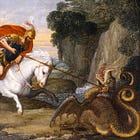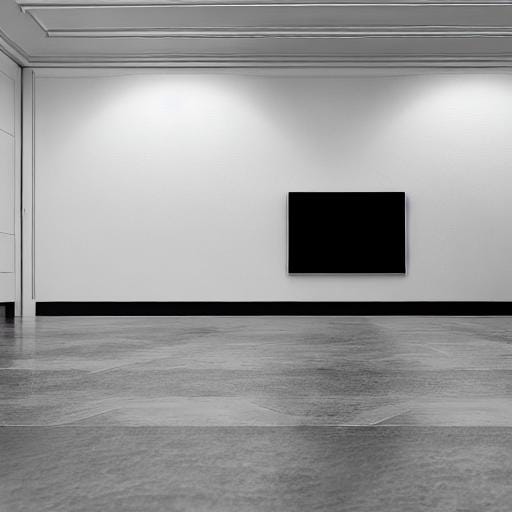Batman - The Black Mirror
"They think I'm hiding in the shadows, but I am the shadows" - Batman (2022)
“Hidden in the chaos is the element, waiting to strike like snakes. But I’m there too. Watching.” -Batman (2022)
This write-up is a brief accompaniment to my most recent Symbolism in Fiction & Gaming post Bilbo Baggins and Right Engagement With the Monster, Part 1. Check it out for context:
Over the last decade and a half, superhero movies have enchanted audiences around the globe with the meteoric rise of the Marvel Cinematic Universe. Beginning with Robert Downey Jr.’s seminal Iron Man, the modern age has chosen its mythology and carved out its pantheon. However, one “superhero” has been a mainstay in cinema for decades longer than almost any other comic book counterpart: The Batman. His filmography isn’t merely the best in a collection of comic book movies, but one of the best filmographies period. Some of the greatest directors, cinematographers, costume artists, sound designers, and actors in the history of film have lent themselves in service to the Bat. I can’t help but wonder why. Why is it that this Caped Crusader has captivated our imaginations for so long, with no sign of loosening his grip?
I believe it is because Batman, despite his many iterations, remains a mystery to us. We understand Bruce Wayne and his motivations, but do we truly understand the Batman? And as Carmine Falcone in Nolan’s Batman Begins puts so well:
“And you always fear what you don’t understand.”
Afraid of the light
As described in my post about right engagement with the monster, monsters are by definition strange. More specifically, they are unknown to us; and what makes them fearsome is their uncanny qualities and unrevealed capabilities. Your brain anxiously attempts to piece the identity of a monster together and usually fails.
Imagine you’re a petty thief in Gotham City. You just robbed a local shopowner with your partner in crime and are now cutting through a zigzag of alleyways. Suddenly, you hear a swoosh; your compatriot is no longer running beside you. The drizzling gloom of this city is by nature hard to pierce, but the imposing shadows seem more impenetrable than usual. There being no honour among thieves, you don’t stop to investigate but continue your escape alone. But then you’re stopped dead in your tracks: a loathsome shade distends before you. Where came this thing? Is it a man? Are those wings of leather? Ears or horns? The only light that escapes the shadows is from a grimacing smile.
Unlike heroes such as Thor, Captain America, or Superman, Batman does not emanate grandeur, virtue, or benevolence. Rather, he cloaks himself in the very essence of the monstrous. Like most superheroes, Bruce Wayne creates a masked alternate persona; however, what makes his Batman more engaging than other alter-egos is that, layered on top of the trope of “protecting loved ones”, is the veiling of his very being. Tony Stark is Iron Man; Clark Kent is Superman; Peter Parker is Spider-Man. They project their specific heroic virtues into the light through their personas. However, Bruce Wayne is not Batman, at least not in my interpretation. Instead, Batman is something else. He is shrouded in mystery. The mystery of the strange - of the monster. Of the things that go bump in the night.
The gargoyle of Gotham
We often see Batman depicted atop a grotesque gargoyle; both creatures looming over a corrupted and fallen city. I do not believe this imagery is arbitrary or merely for grim aesthetics. Instead, Batman and the grotesque are in many ways interrelated. Gargoyles are the strange disturbing creatures that are often spotted on the edges and façades of Gothic architecture - chiefly on cathedrals. At first glance, these strange malformed characters may seem out of place, especially on church walls, but the gargoyle does indeed serve a purpose. Namely, they are spouts at the end of gutters where excess water is drained from. Gargoyles or grotesques (the same type of figure but one that does not spew water) most often take the form of hybrid beasts like the chimera, odd-looking men, or demonic entities. Gothic architecture as a whole was termed during the Renaissance period after the Goths, those tribes of barbarians on the edges of the old Roman Empire. The Italian artists of the Renaissance took these structures to be repulsive and brutish, and so bequeathed a fitting label. If you read the previous article on monsters, you may begin to see where I am going.
Both the gargoyle and the goths are those strange things that live on the boundaries. Creatures that are difficult to understand and offensive to “cultured” eyes. They are the monsters that live on the fringe, the remainder of a society. They inhabit that liminal space, the threshold, between what is safe and known and what is not. With this lens, perhaps it makes sense as to why gargoyles were used to drain the excess water. Without them, the outside waters would build up, overflow, and eventually rot away at the fine masonry of a building. However, it gets more interesting. Gargoyles and grotesques served another purpose, specifically on churches: they represented the demons that were cast out by exorcisms in a holy place. But what’s more, they also served as protectors, guardians of the interior, against other evil spirits. They patrolled the edges and stood fast against mal-intent, keeping the flock within safe from outer destruction. As former stonemason Alex Woodcock notes, the more a grotesque was -well- grotesque, the better it served at catching and redirecting the evil eye.
But what happens when the grotesque moves in from the borders and inhabits the centre? Or if the brethren of the warden gargoyle, those outer forces, were to break through? What kind of place would that look like? If a city became flooded with the monsters on the edge, what would be needed to exercise them?
Black Mirror
We all know that Batman embodies the darkness - he tells us this himself. So it is no revelation why his raiment is black and his cowl bestial. But we also know that Batman isn’t a villain. And if he isn’t a villain, but embodies monstrous qualities, then what is he?
I don’t believe he is an anti-hero. Those are reserved for the Tony Sopranos and Walter Whites of fiction. Where cheering the protagonist on is more of a guilty pleasure than it is a sincere wish to be inspired or protected. Batman has a clear morality; he doesn't kill, he refuses to wield a gun, and has goals that transcend beyond himself. Nevertheless, it’s not hard to attribute some of the harrowing qualities of Gotham City to the ‘Dark Knight’. Besides the obvious parallel in gargoyled appearances, both subject and setting share themes of lost innocence; they struggle with inner demons; Gotham’s dereliction of justice and Batman’s vigilantism pushes them to the edge of a normal society; and ultimately, despite their bleakness, they share a stone-like endurance. In a real sense, Batman is Gotham. Or, rather, a reflection of it. He embodies the same pattern that the protective gargoyle does. The pattern of a looking glass.
Batman is a mirror.
Opposed to the typical hero’s direct and radiating “light” of purity, Batman is instead a reflection - an inversion of light. Consider the story of Snow White with the evil stepmother’s magic mirror. It is a festering pit for this dark queen’s vanity and jealousy. The queen continually returns to the mirror to seek her vain validations, but the mirror can only reflect that which is true - in this case, her resentful covetousness. Unable to bear the truth of the reflection, it consumes her and sets in motion the events leading to her downfall. You can also recall the story of the handsome Narcissus, who falls in love with his reflection in the waters. He is also consumed, even to his death. Or take the Mirror of Erised from Harry Potter and there is a similar trope (becoming enthralled by the heart’s desire). The mirror pulls you in and then reflects your very being - flaws, secrets, and all. If one isn’t ready for the truth, then the mirror becomes a dangerous tool. And if a mirror is framed in the particulars of the monster, then it will draw to it those of a strange grafting of qualities. Luring them in and undoing them with their own devices.
Consider now Batman’s usual suspects: the Joker, Two-Face, the Riddler, Scarecrow, and the Penguin.
The Joker and Batman are the unstoppable-force-meets-immovable-object of comic book characters. The twisted visage and chaos of the Joker are undone by the firm order that exists behind the cowl.
Two-Face’s warped sense of justice always collapses under the reflection of Batman’s steadfast moral code.
The Riddler, desperate for recognition and the feeding of his intellect, is solved by Batman’s cold calculating nature.
The Scarecrow feeds off of fear but cowers when confronted with Batman’s monstrous mien.
And the Penguin, obsessed with wealth and influence, is constantly bested by he who has it all and pays it no mind.
All of these villains shatter under the weight of the truth of their own reflections. When Batman confronts each of them in turn, a different element of his identity is revealed. He is the chimera of comic book heroes, and his many monikers lend themselves to this. His identity is not only veiled by a mastery of the shadows or his dark mantle, but his capabilities are also obscured, and in the violence of Gotham’s nights, his motives are not always obvious.
Bruce Wayne himself must beware The Batman. The persona has an all-consuming effect on Bruce’s life - pulling him in further and further. Even to the point of raising an exceptionally riveting question: who holds the real identity? Who comes first? Who is reflecting who? Batman or Bruce Wayne? I will leave these answers to learned fans.
But one final note is this: the black mirror doesn't only reflect onto its villains, but also back to the audience. We think we know the character, but I believe that each iteration of the Batman is a further attempt to answer his riddle, and this draws us in more and more. To try and piece together the true identity of this terrible creature. The watchful gargoyle, pushed to the edge. This monster who fights monsters.Who properly has wielded the very mantle of the strange. Something even Nietzsche was wary of. And all we can do is continue to stare into the dark abyss of his wings.
Thanks for reading,
Sam
P.S. This addition merely aims to serve in further defining the characteristics of monsters found within popular narratives. I mentioned briefly the idea of the mirror in my previous post and thought it worthwhile to flesh it out before continuing on. Look out for Bilbo Baggins and Right Engagement With the Monster, Part 2.







What do you think about the Joker being almost inevitably more interesting than Batman, at least in the movies.? That may be just me, but I think it isn’t. Or maybe the Joker is more obvious in what is interesting about his character.